Certifications that are making the built environment sustainable
A sustainable built environment is one that is designed and built for longevity, assembly/disassembly, reuse, and circularity, considering climate impacts, and making use of materials and products that are healthy, safe, non-hazardous and have low carbon impact. Certifications and declarations in the construction space help in assessing the environmental and social performance of a building material and ensuring that the product is responsibly sourced, is devoid of hazardous chemicals, healthy, safe, and sustainable. These certifications also help in keeping different stakeholders along the value chain in the construction space aligned through the process of designing and constructing sustainable buildings.
At 2050 Materials, these certifications are an integral part of the products that are listed on the platform, communicating their environmental and social performance. It is a non-exhaustive list aimed at being expanded with time. Read below to understand each certification and datasheet found on the 2050 Materials’ platform.
List of certifications and datasheet found on the 2050 Materials’ platform:
- Cradle to Cradle certification
- Environmental Product Declaration
- Cradle to Cradle Material Health
- Level Certified BIFMA
- AFRDI
- Indoor Advantage
- NaturePlus
- ISO 14001
- Declare Label
- GreenGuard Certification
- Health Product Declaration
- Forest Stewardship Council Certification
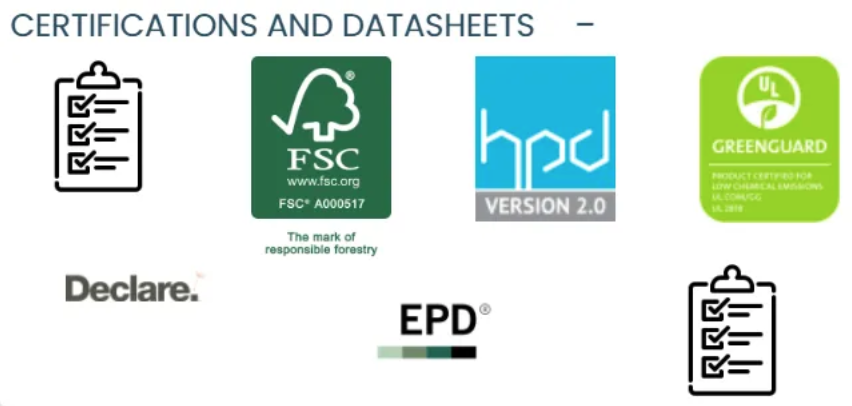
Some of the Certifications and Datasheets for products found on our platform
Some of the certifications that we use on our platform:
Cradle to Cradle certification
Cradle to Cradle is a universal measure that assesses products and materials on standards of safety, circularity, and responsibility on five parameters of sustainability performance. These include:
· Material health — this category ensures that the products and materials are healthy and safe for the environment and the people.
· Product circularity — regenerative processes and process design enable circularity of products
· Clean air and climate protection — the products are assessed on the criteria of protecting clean air, emission reduction, promoting renewable energy
· Water and soil stewardship — this category ensures that clean water and healthy soil are protected
· Social fairness — the products contribute towards a fair and equitable society and respect human rights
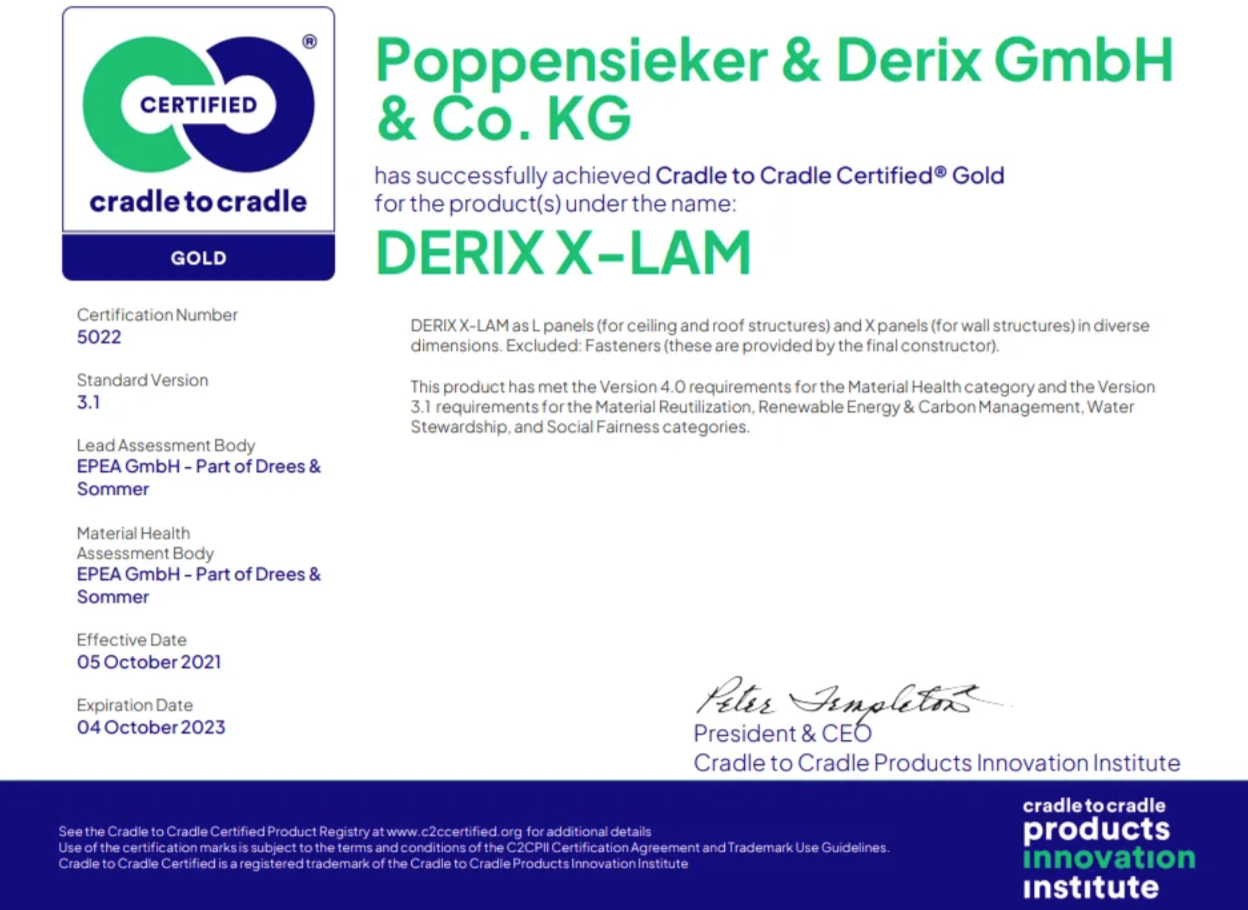
An example of a Cradle to Cradle Certification
Stakeholders across the value chain can depend on Cradle to Cradle certified products to have a positive impact on people and planet. The certification also acts as a catalyst for companies to optimize materials as per science-based measures through innovation.
Companies need to work with qualified third-party assessment bodies to certify products under Cradle to Cradle or Material Health Certification to make sure that the products meet the certifications standards.
Environmental Product Declaration
An Environmental Product Declaration (EPD) is a document that reports the environmental performance and impact of a material/product over its lifetime in a transparent manner.
EPDs fall under the International EPD System, help manufacturers convey their commitment towards assessing, reporting, and reducing the environmental impact of their products. EPDs aid in quantifying information on environmental performance of a product that facilitates comparison of products within the same function. EPD assessment is based on Life-cycle assessment (LCA); a methodology that measures the environmental impact of a product associated with all the stages of its life cycle, taking into consideration the entire value chain, from material extraction to manufacturing, to use and end of life stage.
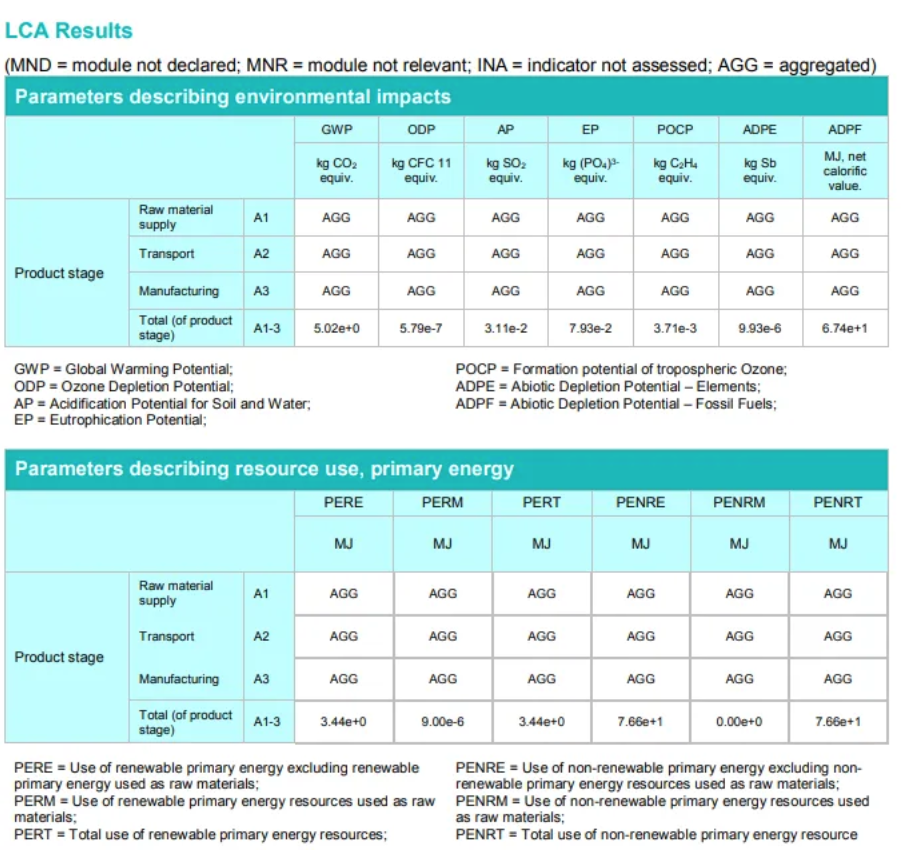
Environmental Product Declaration
EPDs are considered type III environmental declaration which are compliant with the ISO 14025 standard. EPDs differ from ISO type I third-party which are independent eco-labels and type II which are self-declared eco-labels.
The EN15804 standard ensures that the EPDs in the construction space are transparent and comparable allowing for sustainability assessment of the construction works. Revised version of the standard, EN15804 + A2 makes the EPDs more aligned with the Product Environmental Footprint, a requisite driving companies to carry out more reliable environmental assessments including biogenic carbon reporting, greater focus on circularity and more life cycle stages among others.
Currently, there is high variance in data quality and specificity of EPDs which leads to erroneous and misleading comparisons. Also, having an EPD of a product does not indicate that the declared product is environmentally healthier than other alternative products.
Cradle to Cradle Material Health Certification
The certification is a standard assessing the use of chemicals in products along the value chain. It is considered an important building block that helps in improving material health of products on the way to cradle to cradle certification. Cradle to Cradle certified product standard’s rigorous, and internationally accepted material health measurement system is used by the Material Health Certification. It helps in ensuring that the products are safe for people and the environment.
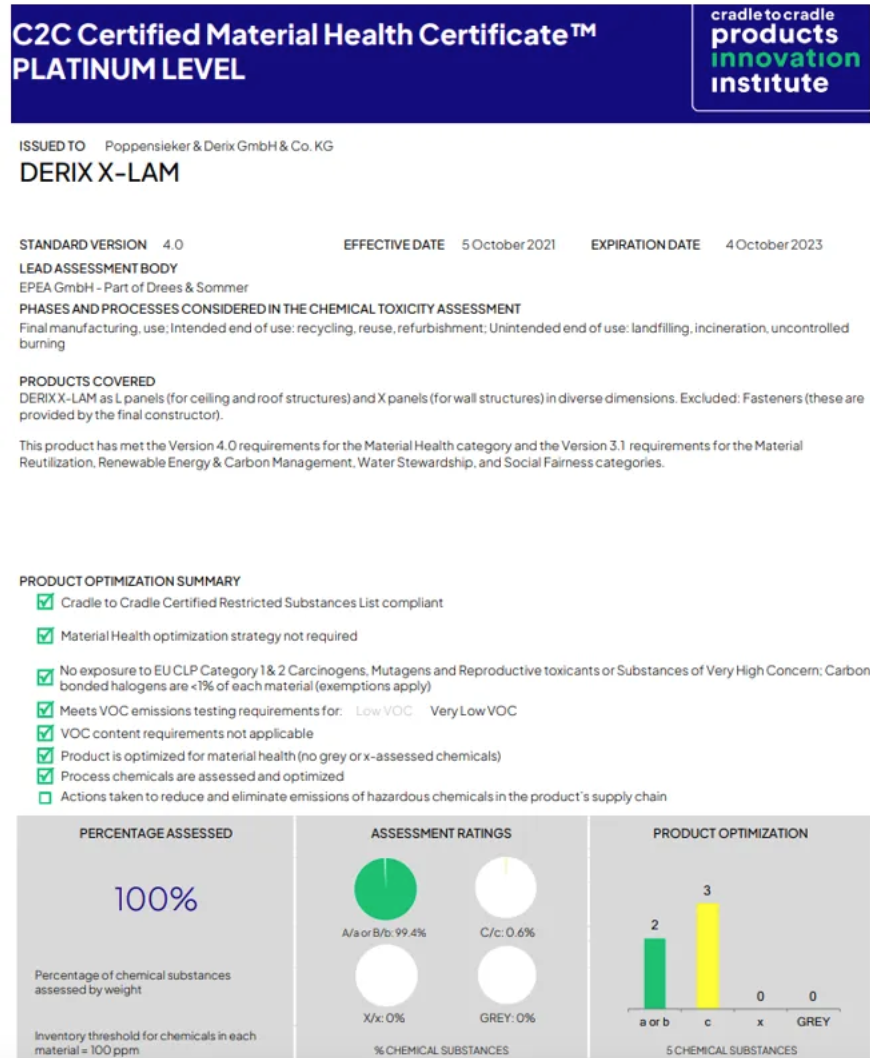
LEVEL Certified BIFMA
LEVEL certification is by BIFMA, a not-for-profit trade association a key stakeholder in the commercial furniture industry. It addresses the significant people and planet impacts that are associated with furniture products.
What can you learn from it? It supports and looks into the development and maintenance of safety, performance and sustainability criteria of furniture that have an impact on people’s lives. The standards measured include chemicals, manufacturing processes, and well-being of people. The certification is complementary with LEED, WELL and others and helps in making responsible decisions.
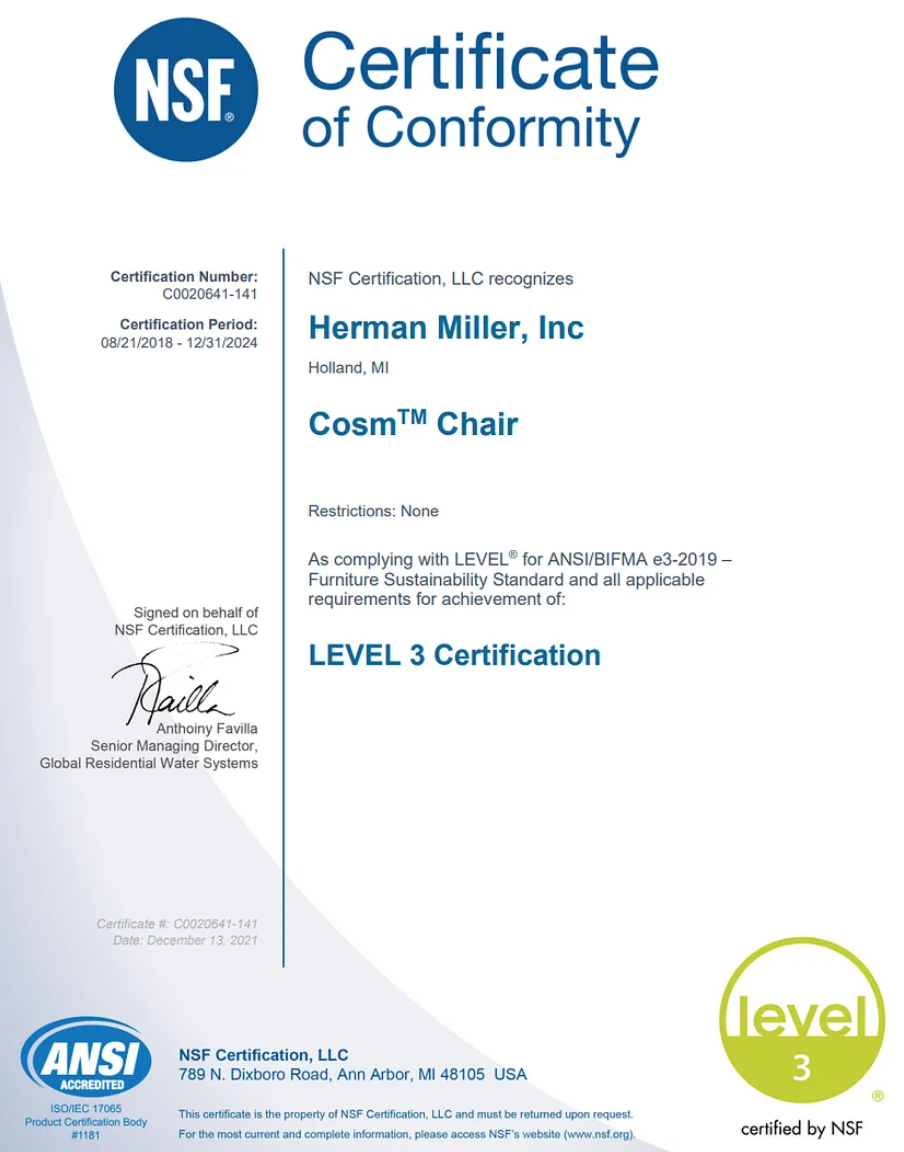
LEVEL Certified BIFMA
AFRDI — Australasian Furnishing Research and Development Institute Certification
AFRDI is not-for-profit research agency that provides standards, testing of products and certification in the furniture marketplace. Furniture with AFRDI logo and certification are ensured of high quality and standards on safety and strength and durability. AFRDI provides high quality testing and certification services that are recognized across the globe in both commercial and domestic furniture space.
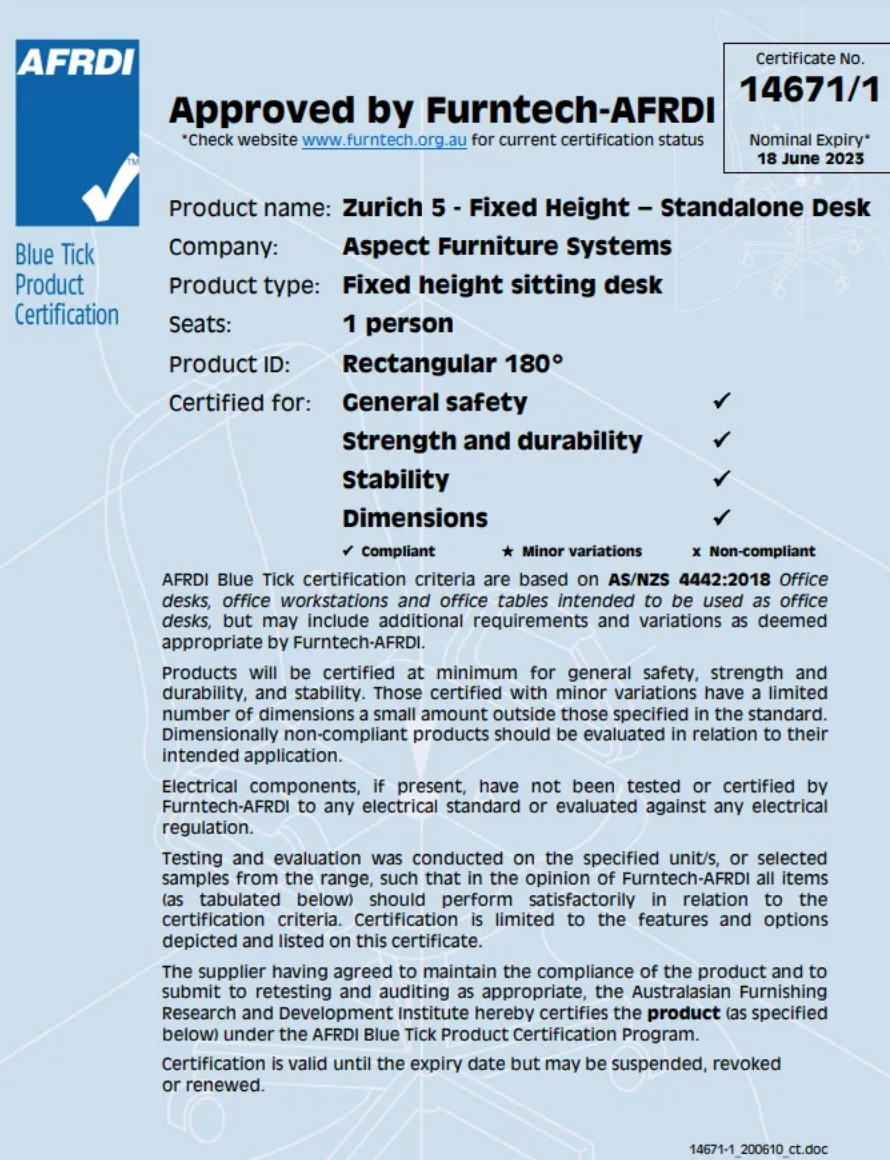
AFRDI
Indoor Advantage
Indoor Advantage standard assesses the indoor air quality and interior products on the basis of VOC emission of furniture and building products. It falls under SCS, an international third-party certifying, body and is accepted by EPA and GSA and qualifies for several building rating entities including BREEAM, LEED v4.1, WELL, Living Building Challenge.
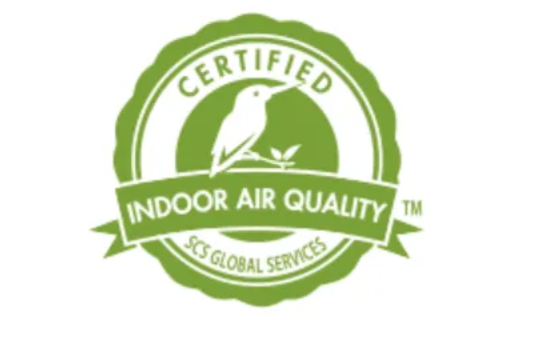
Indoor Advantage
NaturePlus certification
NaturePlus aims to promote sustainable construction by aligning the interests of different stakeholders in the building space with “environmental and consumer protection agencies and trade union” and scientists in Europe.
The certification lays out guidelines for defining the requirements and criteria of NaturePlus eco-label. All products with the certification need to meet basic guidelines (GL 5000) along with the respective product-specific guideline. These guidelines and standards are around chemicals, low emissions, preservation of mineral resources, transparency, and social responsibility.
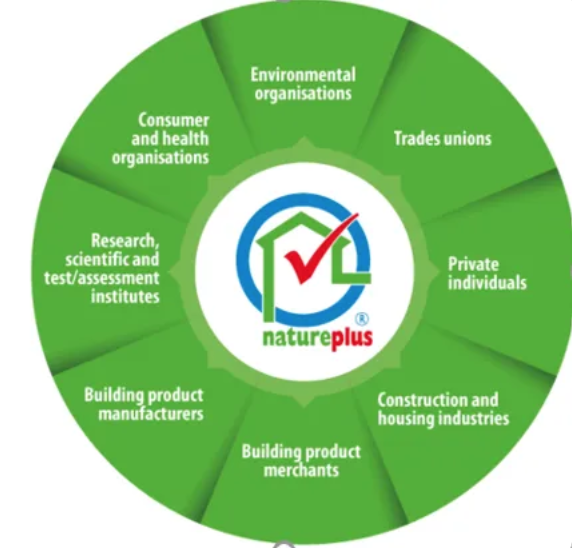
Natureplus
ISO 14001
ISO 14001 is an internationally agreed upon standard which lays down the requirements for an environmental management system. It supports organizations by improving their environmental performance through the efficient management of their resources and waste reduction. They also help the organizations to gain competitive advantage and trust of key stakeholders. The standard falls under the ISO national standard body; an independent and non-governmental organization.
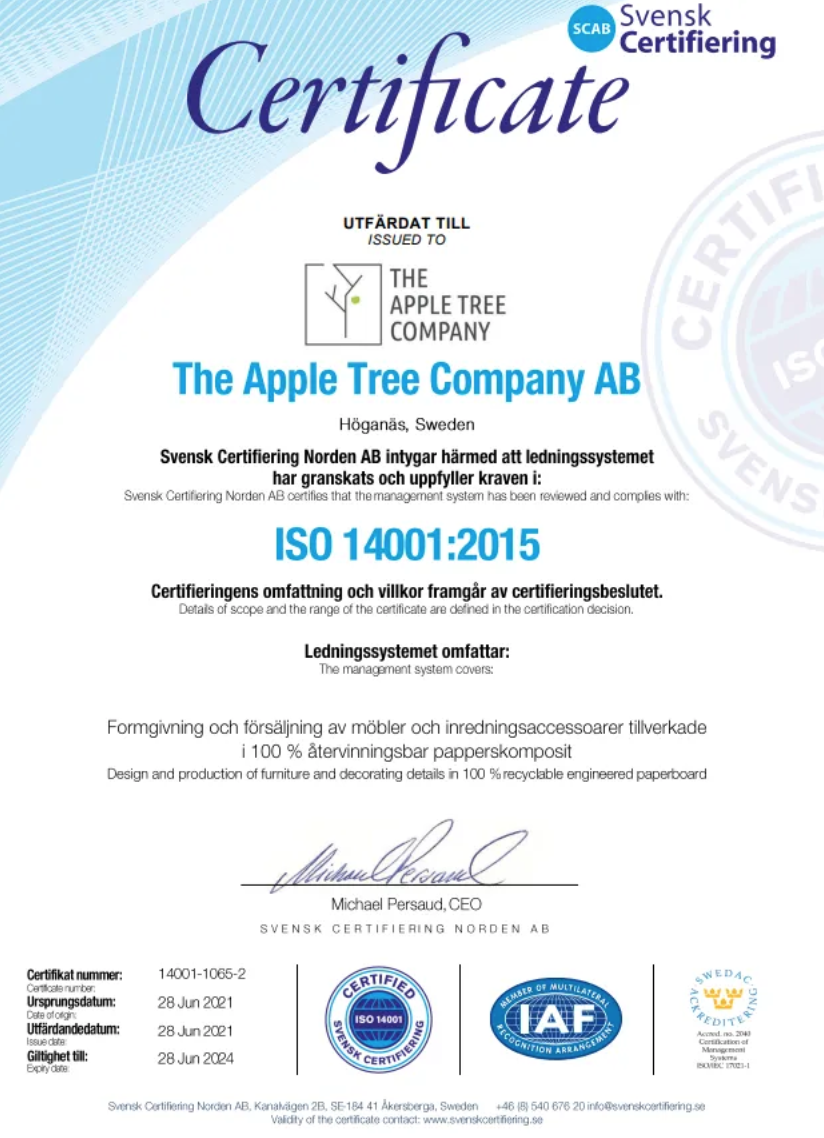
ISO 14001
Declare label
Declare Label is considered a “nutrition label” for building products. Developed by the International Living Future Institute, the label promotes sustainability by disclosing and listing information about a product’s ingredients, material make-up, its source location and end-of-life treatment. Declare label is also considered a compliance pathway for LEED v4 and contains an analysis of ingredients that are restricted and are Red List chemicals. With the given information, a consumer can make choices to ensure a healthier living-built environment.
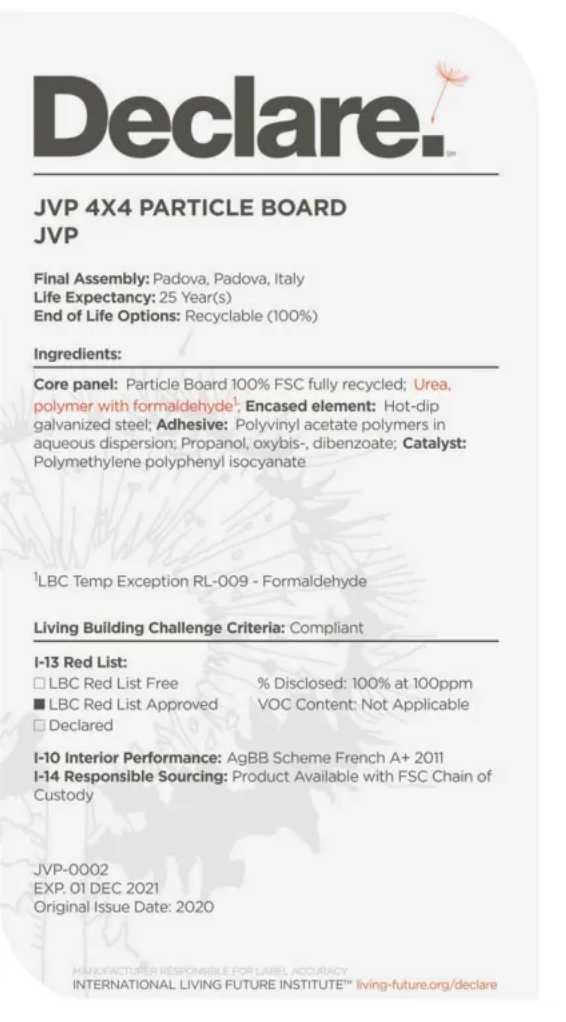
Declare label
GREENGUARD certification
GREENGUARD certification tests a product for low chemical emissions and ensures that the product emit only low quantities of VOCs which are low volatile organic compounds. GREENGUARD certification has a significant role in ensuring indoor air quality is healthy by helping consumers in the building industry with resources and information to identify more sustainable products. It also supports manufacturers by providing them with tools that help them promote their sustainability efforts and meet industry standards.
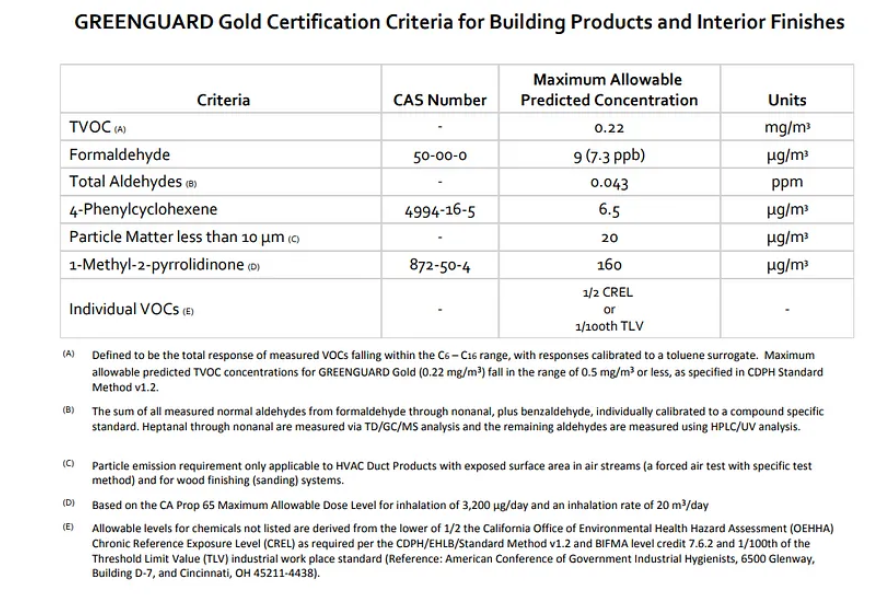
GREENGUARD Certification
Health Product Declarations
Health Product Declarations are standardized way of providing a complete disclosure and transparency of the ingredients and related material health information of products that are used in the built environment. The disclosure includes list of potential chemicals of concern, compared with hazard lists provided by different government agencies. They fall under HPD standard and support all stakeholders across the value chain of building industry by providing them with information to improve the transparency and material health of buildings and built environment. They are consistent with programs including International Living Future Institute, LEED, WELL among others.
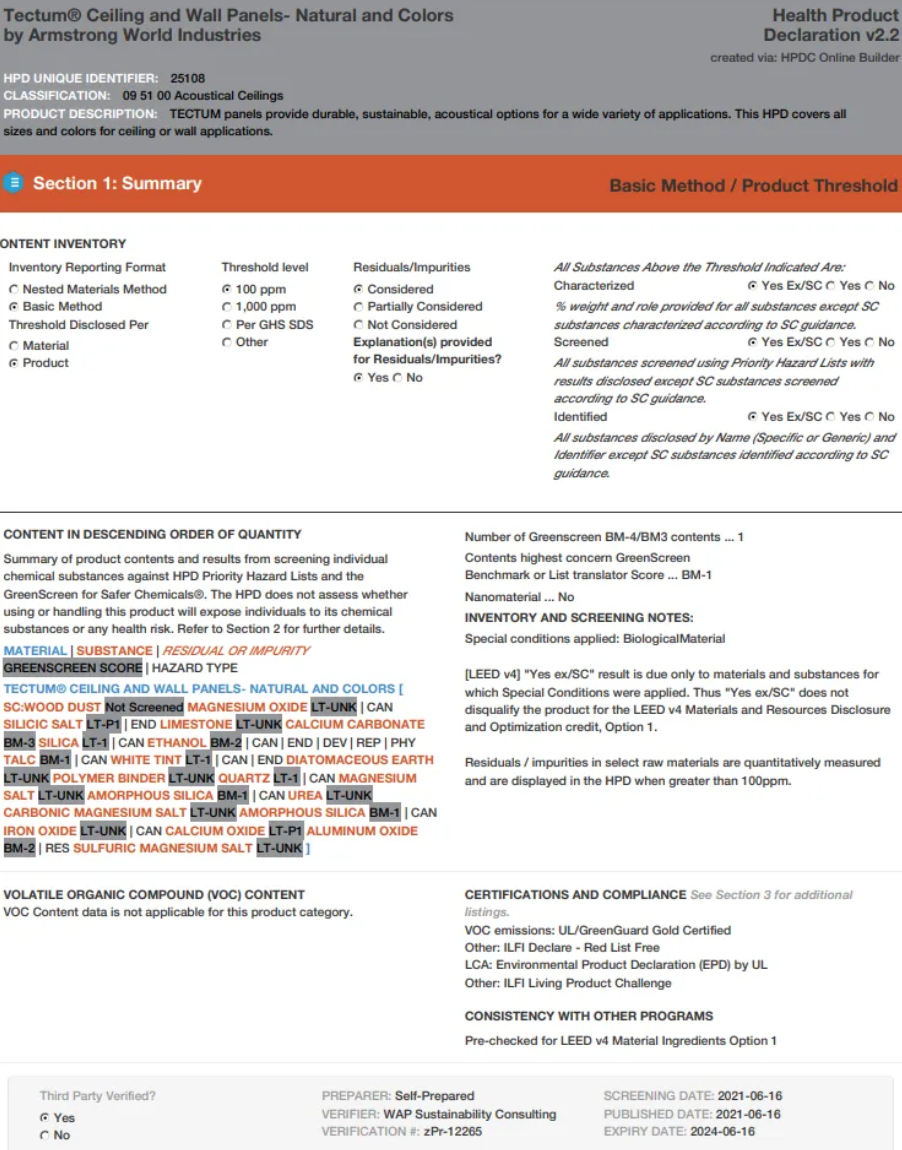
Health product declaration
Forest Stewardship Council Certification
Forest Stewardship Council Certification sets standards for forest management and certifies that the products are derived from “responsibly managed forests” that deliver on social, environmental, and economic benefits. An FSC-certified product expands standards on environmental, social, and economic parameters including prevention of loss of natural cover, protection of water quality, protection of rights of indigenous people, access to markets among others.
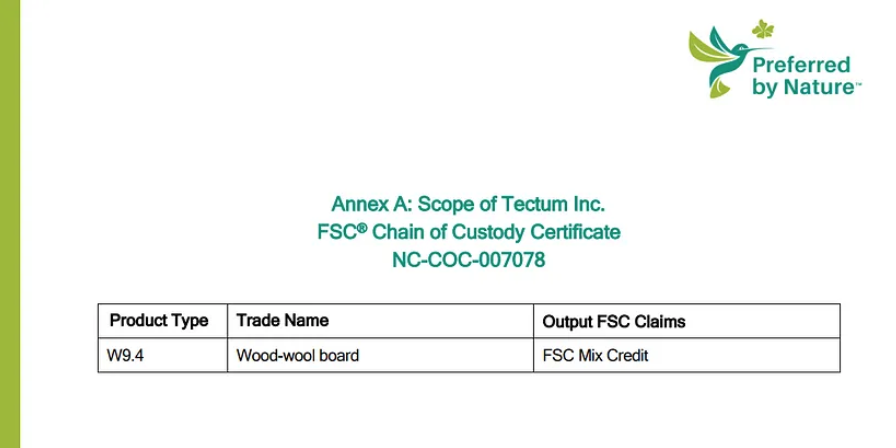
Forest Stewardship Council Certification
How can you see theses certifications for products on the 2050 platform?
On the platform, one can find all the certifications on the product listing page, which can be viewed by clicking on the dropdown to look at the entire list of certifications.
To summarize, the list of certifications that we use on our platform and the associated data reliability parameters are as follows:
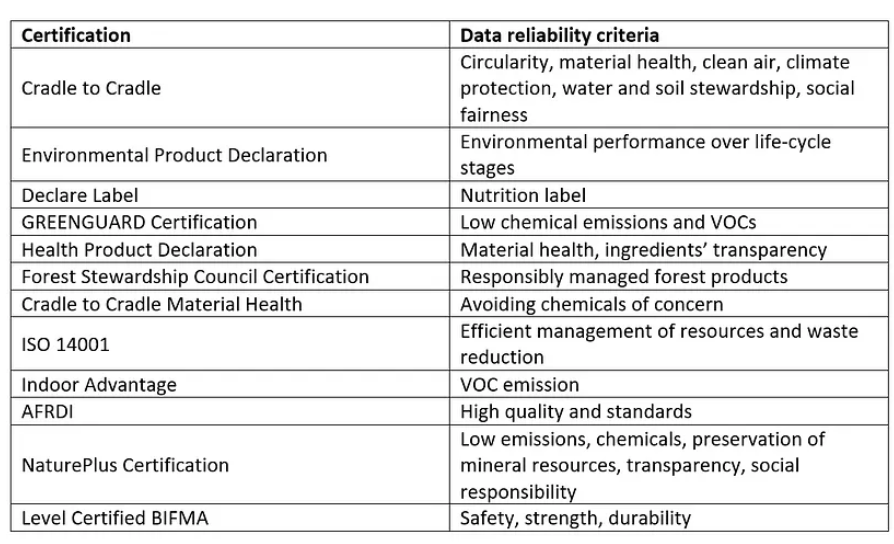
Summarized table of certifications and associated data reliability criteria
For any questions or suggestions to help us improve our approach, reach out to us at info@2050-materials.com
The 2050 Materials team
Related articles

Climate-Resilient Materials for the Built Environment: A Data-Centred Prime
As climate volatility intensifies, resilience metrics are fast becoming as critical as carbon data in material selection. This article outlines why adaptation is now a design imperative, how materials can be evaluated through a systems lens, and what KPIs project teams should demand. From self-healing concrete to fire-rated façades, we present a structured taxonomy of resilient materials, explain how to embed this intelligence into digital design workflows, and propose next steps for specification, benchmarking, and procurement.
Read more
The Most Interesting Low Carbon Products in Office Design
In this article and collection, we highlight 11 outstanding products that contribute to a lower carbon footprint in office design.
Read more
Top Low Carbon Building Boards: Performance, Benefits, and Use Cases
The building boards highlighted in this article and collection showcase low-carbon innovation in modern construction.
Read more